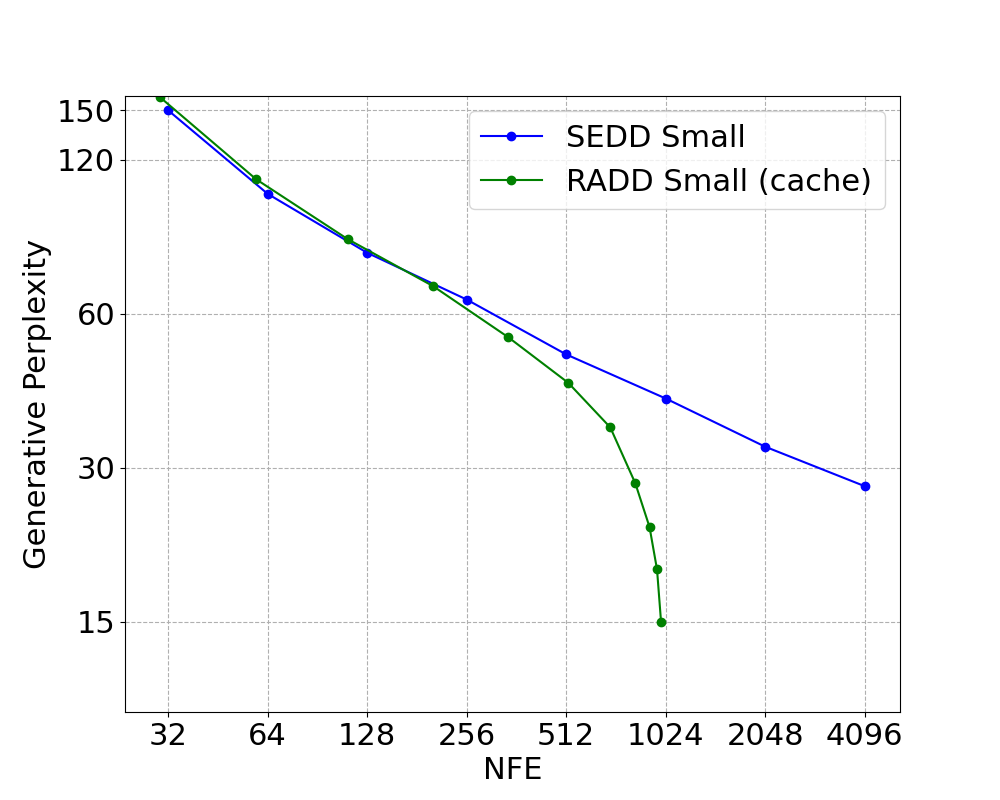This repo contains an official PyTorch implementation for the paper Your Absorbing Discrete Diffusion Secretly Models the Conditional Distributions of Clean Data by Jingyang Ou, Shen Nie, Kaiwen Xue, Fengqi Zhu, Jiacheng Sun, Zhenguo Li and Chongxuan Li.
We propose reparameterized absorbing discrete diffusion (RADD), a dedicated diffusion model without time condition that characterizes the time-independent conditional probabilities. From this perspective, we demonstrated the unification of training objectives for absorbing discrete diffusion and any-order autoregressive models. Further, the removal of time condition allows for caching strategies to reduce the number of function evaluations.
This codebase contains:
- Implementation of the time-independent RADD architecture
- Sampling code for both diffusion-based and any-order auto-regressive methods
- Training code with four different loss functions
- Evaluation code for zero-shot performance
run_train_ddp.py: Codes for trainingsampling.py: Codes for samplingnoise_lib.py: The noise schedule and forward diffusionmodel/: The model architecturenoise_lib.py: The noise schedule and the forward processlosses.py: Loss functions
Create a conda environment containing the required dependencies:
conda env create -f environment.yml
conda activate radd
Our RADD models, trained for 400k steps with different loss functions, are available on Hugging Face:
| Model | Loss function |
|---|---|
| radd-lambda-dce |
|
| radd-t-dce |
|
For example, to load the radd-t-dce model and noise schedule, use the following code:
from load_model import load_model
model, noise = load_model('JingyangOu/radd-t-dce', device='cuda') In sampling.py, we provide two samplers: DiffusionSampler for diffusion-based sampling and OrderedSampler for any-order auto-regressive sampling.
To perform any-order auto-regressive sampling, we need to define the generation order first. For example, we can use the following code to generate text in a forward order (0, 1, ..., args.length - 1):
forward_order = torch.arange(0, args.length)
sampler = OrderedSampler(model, (args.batch_size, args.length), token_dim, args.strategy, args.strategy_para, forward_order, device=device)
samples = sampler.sample(args.steps)Additionally, OrderedSampler supports top_p and top_k sampling strategies, in addition to the direct sampling strategy. Below is an script of using the top_p strategy:
python run_sample.py \
--model_path JingyangOu/radd-t-dce \
--batch_size 1 \
--length 1024 \
--steps 1024 \
--method ordered \
--strategy top_p \
--strategy_para 0.8The DiffusionSampler can be used with either the Tweedie
python run_sample.py \
--model_path JingyangOu/radd-t-dce \
--batch_size 2 \
--length 1024 \
--steps 1024 \
--method tweedie \
--strategy direct To perform conditional sampling, we can use the DiffusionSampler with the prefix and suffix argument.
python run_sample_cond.py \
--model_path JingyangOu/radd-lambda-dce \
--batch_size 1 \
--length 1024 \
--steps 1024 \
--method tweedie \
--strategy direct \
--prefix "THIS IS PREFIX" \
--suffix "THIS IS SUFFIX"We offer training code with Distributed Data Parallel (DDP) support for both single-machine multi-GPU setups and multi-machine multi-GPU configurations:
# single machine with multiple GPUs
torchrun --nnodes NNODES run_train_ddp.py
# multiple machines with multiple GPUs
torchrun --nnodes NNODES --nproc_per_node NPROC_PER_NODE --master-addr MASTER_ADDR --node-rank NODE_RANK run_train_ddp.py A new directory output/DATE/TIME with the following structure will be created for each run:
├── output
│ ├── .hydra
│ │ ├── config.yaml
│ │ ├── ...
│ ├── checkpoints
│ │ ├── checkpoint_*.pth
│ ├── checkpoints-meta
│ │ ├── checkpoint.pth
│ ├── samples
│ │ ├── iter_*
│ │ │ ├── sample_*.txt
│ ├── wandb
│ │ ├── ...
│ ├── logs
Here, checkpoints-meta is used for reloading the run following interruptions, samples contains generated images as the run progresses, and logs contains the run output. Arguments can be added with ARG_NAME=ARG_VALUE, with important ones being:
ngpus the number of GPUs allocated for training (utilizing PyTorch DDP)
model options include small_radd, medium_radd
noise.type options include geometric, loglinear
training.accum the number of gradient accumulation steps
training.loss_type options include t_DSE, t_DCE, lambda_DCE, k_DCE
We have developed four distinct loss functions for RADD, detailed in losses.py. The desired loss function can be specified using the training.loss_type argument:
| Argument | Loss function |
|---|---|
t_DSE |
DSE loss |
t_DCE |
|
lambda_DCE |
|
k_DCE |
any-order loss |
For example, to train a model using the
# Train a model with t-DCE loss with 8 * A100 80G GPUs in a single machine
torchrun --nproc-per-node=8 train_ddp.py noise.type=loglinear model=small_radd ngpus=8 training.accum=1 training.loss_type=t_DCETo evaluate the zero-shot performance of the trained model, we provide an evaluation script to calculate the model's perplexity (PPL) on a specified test dataset. Below is the example usage of the evaluation script:
python evaluation_modeling.py \
--batch_size 16 \
--model_path JingyangOu/radd-lambda-dce \
--length 1024 \
--valid_dataset ptb \
--monte_carlo_timesteps 1024 \
--ngpus 4 \
--loss_type lambda_DCE \
--work_dir ./logs/radd-lambda-dceThis will output the evaluation perplexity (PPL) in the specified work_dir. Make sure to adjust the arguments according to your setup and dataset.
This repository was built off SEDD.
@misc{ou2024absorbingdiscretediffusionsecretly,
title={Your Absorbing Discrete Diffusion Secretly Models the Conditional Distributions of Clean Data},
author={Jingyang Ou and Shen Nie and Kaiwen Xue and Fengqi Zhu and Jiacheng Sun and Zhenguo Li and Chongxuan Li},
year={2024},
eprint={2406.03736},
archivePrefix={arXiv},
primaryClass={cs.LG},
}



